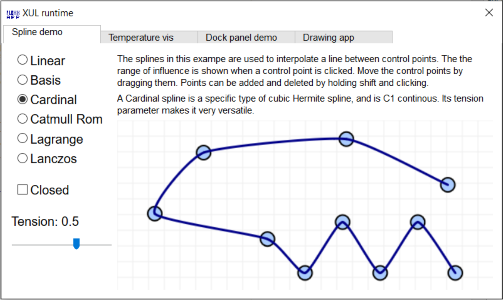Description
Being pure Python and cross platform, it should work anywhere where
there's Python and a browser. To run apps in desktop-mode, we recommend having Firefox
installed.
Flexx has a modular design, consisting of a few subpackages, which can
also be used by themselves:
Flexx alternatives and similar packages
Based on the "GUI" category.
Alternatively, view Flexx alternatives based on common mentions on social networks and blogs.
-
Textual
The lean application framework for Python. Build sophisticated user interfaces with a simple Python API. Run your apps in the terminal and a web browser. -
PySimpleGUI
Python GUIs for Humans! PySimpleGUI is the top-rated Python application development environment. Launched in 2018 and actively developed, maintained, and supported in 2024. Transforms tkinter, Qt, WxPython, and Remi into a simple, intuitive, and fun experience for both hobbyists and expert users. -
DearPyGui
Dear PyGui: A fast and powerful Graphical User Interface Toolkit for Python with minimal dependencies -
Flet
Flet enables developers to easily build realtime web, mobile and desktop apps in Python. No frontend experience required. -
Eel
DISCONTINUED. A little Python library for making simple Electron-like HTML/JS GUI apps [Moved to: https://github.com/ChrisKnott/Eel] -
Python version of the Atlas toolkit
World's lightest toolkit to quickly and easily add a GUI to your Python programs and bring them online. -
Qt Style Sheet Inspector
A inspector to be able to view and edit Qt style sheet while an application is running -
PyQt
Python bindings for the Qt cross-platform application and UI framework, with support for both Qt v4 and Qt v5 frameworks.
InfluxDB - Power Real-Time Data Analytics at Scale

* Code Quality Rankings and insights are calculated and provided by Lumnify.
They vary from L1 to L5 with "L5" being the highest.
Do you think we are missing an alternative of Flexx or a related project?
Popular Comparisons
README
Flexx
Want to stay up-to-date about (changes to) Flexx? Subscribe to the NEWS issue.
Introduction
Flexx is a pure Python toolkit for creating graphical user interfaces (GUI's), that uses web technology for its rendering. Apps are written purely in Python; The PScript transpiler generates the necessary JavaScript on the fly.
You can use Flexx to create (cross platform) desktop applications, web applications, and export an app to a standalone HTML document. It also works in the Jupyter notebook.
The docs are on Readthedocs. the code is on Github.
Example
Click the image below for an interactive example:
Motivation
The primary motivation for Flexx is the undeniable fact that the web (i.e. browser technology) has become an increasingly popular method for delivering applications to users, also for (interactive) scientific content.
The purpose of Flexx is to provide a single application framework to create desktop applications, web apps, and (hopefully someday) mobile apps. By making use of browser technology, the library itself can be relatively small and pure Python, making it widely available and easy to use.
A word of caution
Flexx is very versatile and can be used in different ways. It also makes it easy to mix Python that runs on the server and Python that runs in the browser. This is a powerful feature but this also makes it easy to create code that becomes difficult to maintain. You, the developer, must ensure that Python and PScript code are clearly separated.
Installation
Flexx requires Python 3.5+ and also works on pypy. Further, it depends on:
- the Tornado library (pure Python).
- the PScript library (a pure Python flexxui project).
- the Webruntime library (a pure Python flexxui project).
- the Dialite library (a pure Python flexxui project).
To install the latest release (and dependencies), use either of:
# Install latest release
pip install flexx
# Install latest from Github
pip install -U https://github.com/flexxui/flexx/archive/master.zip
Or get the bleeding edge with:
pip install https://github.com/flexxui/flexx/archive/master.zip
Supported browsers
Flexx aims to support all modern browsers, including Firefox, Chrome and Edge. Internet Explorer version 10 and up should work, but some things may be flaky.
For running desktop apps, it is needed to have Firefox or NW.js installed.
License
Flexx makes use of the liberal 2-clause BSD license. See LICENSE for details.
*Note that all licence references and agreements mentioned in the Flexx README section above
are relevant to that project's source code only.


